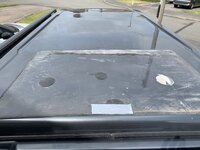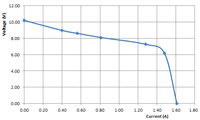I've had a similar voltage drop problem with my 3.5 year old 100w PV Logic Flexi panel - worked perfectly for 3 years but then zero voltage when ever the sun shone, though for around 15 minutes around dusk and when the temperature dropped, I was seeing 12.49v coming from the panel. The 100w panels have a rear exit (where my hole in roof, covered in duct tape, is in the photo below) with the shading diodes in a remote connection box - no evidence of the water ingress/corrosion reported above in the connections/wires coming from the back of the panel.
I can't fault the customer service from Solar Technology International - I used their online form and was contacted back within the hour by Adrian who agreed, from what I'd reported, that the panel was duff and would be replaced under warranty - new panel due to arrive on Tuesday.
The advice from Adrian, which I'm wishing I'd listened to, was to leave the original panel in situ and fix the replacement on top - as the new one is circa 25mm wider I thought this would be better than having to fill the overhang. After a lot of effort we got the panel off and now "just" need to get the remnants of the polyurethane glue off. However, I pulled a bit too hard on one area and a section of the gel coat came away - not bothered about the look as it will be covered by the replacement panel - am I OK to leave the damaged section with exposed fibres or is it best to repair (and, if so, what with) - worried that if I don't repair it the damage could creep below the gelcoat?
When it comes to affixing the new panel - looking at what a pig this one was to get off and how my early worries of the panel flying off on the motorway where totally groundless, I'm intending to just apply a bead of Terason MS939 around the outside edge and not bother with any blobs/lines in the middle. Also, taking on board the comments about trapped air above, I might drill a second small hole in the pop top (below the panel but outside of the canvas area). Sound OK??

I can't fault the customer service from Solar Technology International - I used their online form and was contacted back within the hour by Adrian who agreed, from what I'd reported, that the panel was duff and would be replaced under warranty - new panel due to arrive on Tuesday.
The advice from Adrian, which I'm wishing I'd listened to, was to leave the original panel in situ and fix the replacement on top - as the new one is circa 25mm wider I thought this would be better than having to fill the overhang. After a lot of effort we got the panel off and now "just" need to get the remnants of the polyurethane glue off. However, I pulled a bit too hard on one area and a section of the gel coat came away - not bothered about the look as it will be covered by the replacement panel - am I OK to leave the damaged section with exposed fibres or is it best to repair (and, if so, what with) - worried that if I don't repair it the damage could creep below the gelcoat?
When it comes to affixing the new panel - looking at what a pig this one was to get off and how my early worries of the panel flying off on the motorway where totally groundless, I'm intending to just apply a bead of Terason MS939 around the outside edge and not bother with any blobs/lines in the middle. Also, taking on board the comments about trapped air above, I might drill a second small hole in the pop top (below the panel but outside of the canvas area). Sound OK??


